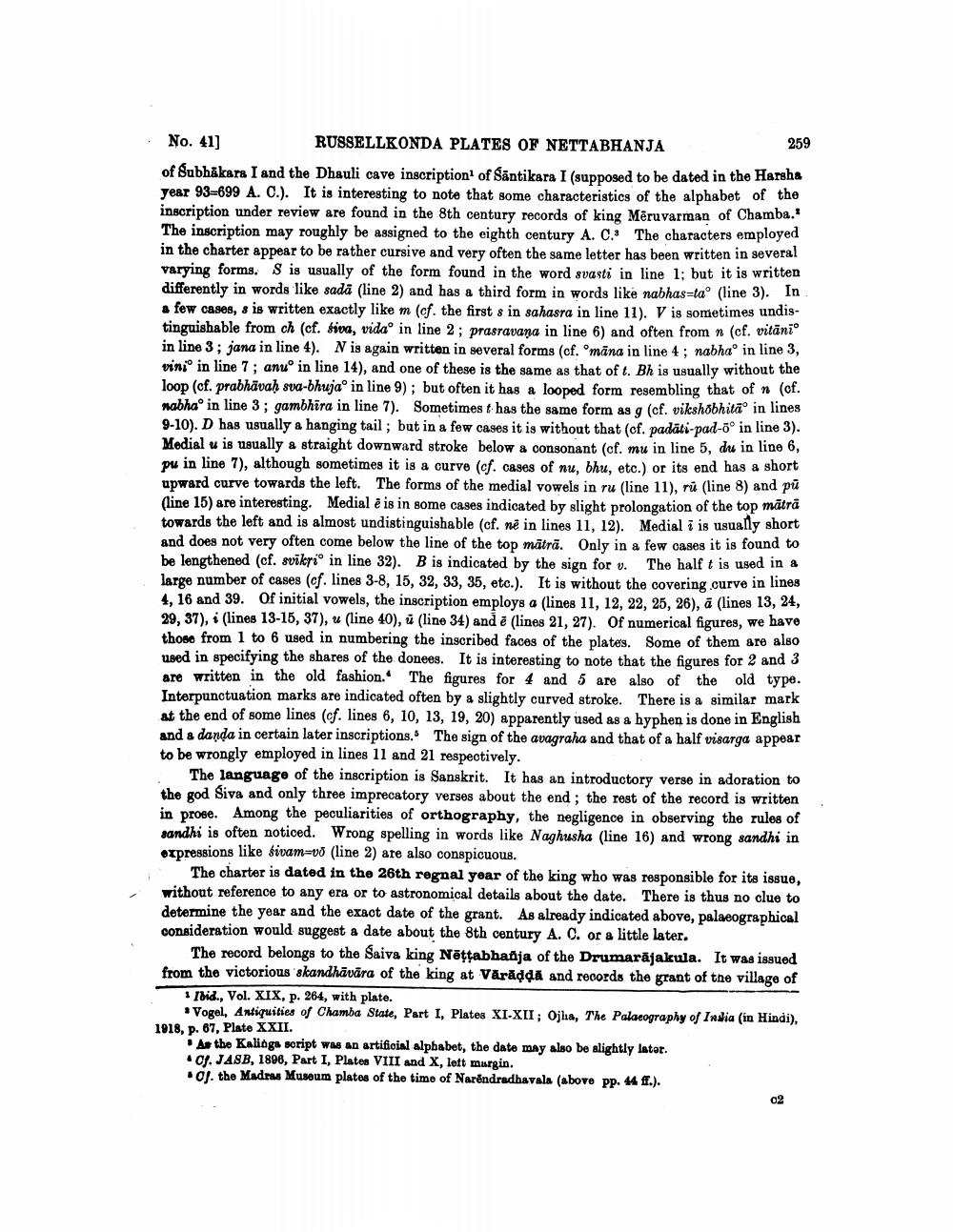________________
No. 41]
RUSSELLKONDA PLATES OF NETTABHANJA
of Subhakara I and the Dhauli cave inscription1 of Santikara I (supposed to be dated in the Harsha year 93-699 A. C.). It is interesting to note that some characteristics of the alphabet of the inscription under review are found in the 8th century records of king Meruvarman of Chamba. The inscription may roughly be assigned to the eighth century A. C. The characters employed in the charter appear to be rather cursive and very often the same letter has been written in several varying forms. S is usually of the form found in the word svasti in line 1; but it is written differently in words like sadā (line 2) and has a third form in words like nabhas-ta (line 3). In a few cases, s is written exactly like m (cf. the first s in sahasra in line 11). V is sometimes undistinguishable from ch (cf. siva, vida in line 2; prasravana in line 6) and often from n (cf. vitani in line 3; jana in line 4). N is again written in several forms (cf. °mana in line 4; nabha° in line 3, vini in line 7; anu° in line 14), and one of these is the same as that of t. Bh is usually without the loop (cf. prabhavaḥ sva-bhuja° in line 9); but often it has a looped form resembling that of n (cf. nabha in line 3; gambhira in line 7). Sometimes t has the same form as g (cf. vikshobhita in lines 9-10). D has usually a hanging tail; but in a few cases it is without that (cf. padati-pad-o° in line 3). Medial u is usually a straight downward stroke below a consonant (cf. mu in line 5, du in line 6, pu in line 7), although sometimes it is a curve (cf. cases of nu, bhu, etc.) or its end has a short upward curve towards the left. The forms of the medial vowels in ru (line 11), ru (line 8) and pu (line 15) are interesting. Medial è is in some cases indicated by slight prolongation of the top mātrā towards the left and is almost undistinguishable (cf. në in lines 11, 12). Medial i is usually short and does not very often come below the line of the top matra. Only in a few cases it is found to be lengthened (cf. svikri in line 32). B is indicated by the sign for v. The half t is used in a large number of cases (cf. lines 3-8, 15, 32, 33, 35, etc.). It is without the covering curve in lines 4, 16 and 39. Of initial vowels, the inscription employs a (lines 11, 12, 22, 25, 26), a (lines 13, 24, 29, 37), i (lines 13-15, 37), u (line 40), u (line 34) and è (lines 21, 27). Of numerical figures, we have those from 1 to 6 used in numbering the inscribed faces of the plates. Some of them are also used in specifying the shares of the donees. It is interesting to note that the figures for 2 and 3 are written in the old fashion. The figures for 4 and 5 are also of the old type. Interpunctuation marks are indicated often by a slightly curved stroke. There is a similar mark at the end of some lines (cf. lines 6, 10, 13, 19, 20) apparently used as a hyphen is done in English and a danda in certain later inscriptions. The sign of the avagraha and that of a half visarga appear to be wrongly employed in lines 11 and 21 respectively.
5
The language of the inscription is Sanskrit. It has an introductory verse in adoration to the god Siva and only three imprecatory verses about the end; the rest of the record is written in prose. Among the peculiarities of orthography, the negligence in observing the rules of sandhi is often noticed. Wrong spelling in words like Naghusha (line 16) and wrong sandhi in expressions like sivam-vo (line 2) are also conspicuous.
259
The charter is dated in the 26th regnal year of the king who was responsible for its issue, without reference to any era or to astronomical details about the date. There is thus no clue to determine the year and the exact date of the grant. As already indicated above, palaeographical consideration would suggest a date about the 8th century A. C. or a little later.
The record belongs to the Saiva king Neṭṭabhañja of the Drumarajakula. It was issued from the victorious skandhavara of the king at Värāḍḍa and records the grant of the village of
Ibid., Vol. XIX, p. 264, with plate.
Vogel, Antiquities of Chamba State, Part I, Plates XI-XII; Ojha, The Palaeography of India (in Hindi), 1918, p. 67, Plate XXII.
As the Kalinga script was an artificial alphabet, the date may also be slightly later.
Cf. JASB, 1896, Part I, Plates VIII and X, lett margin.
OJ. the Madras Museum plates of the time of Narendradhavala (above pp. 44 ff.).
02




